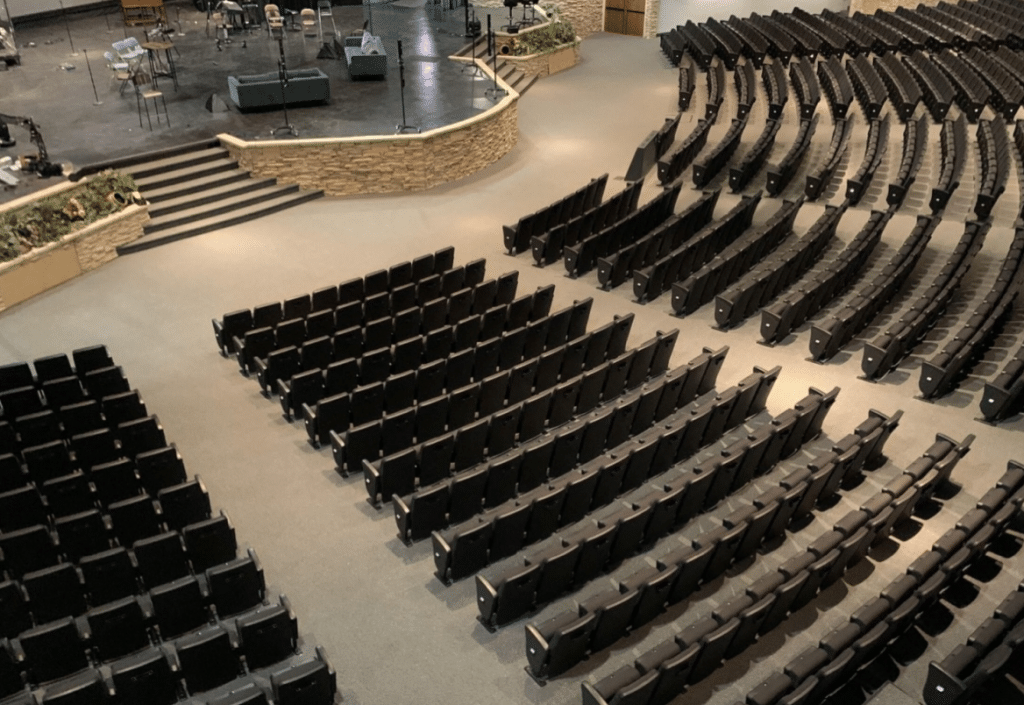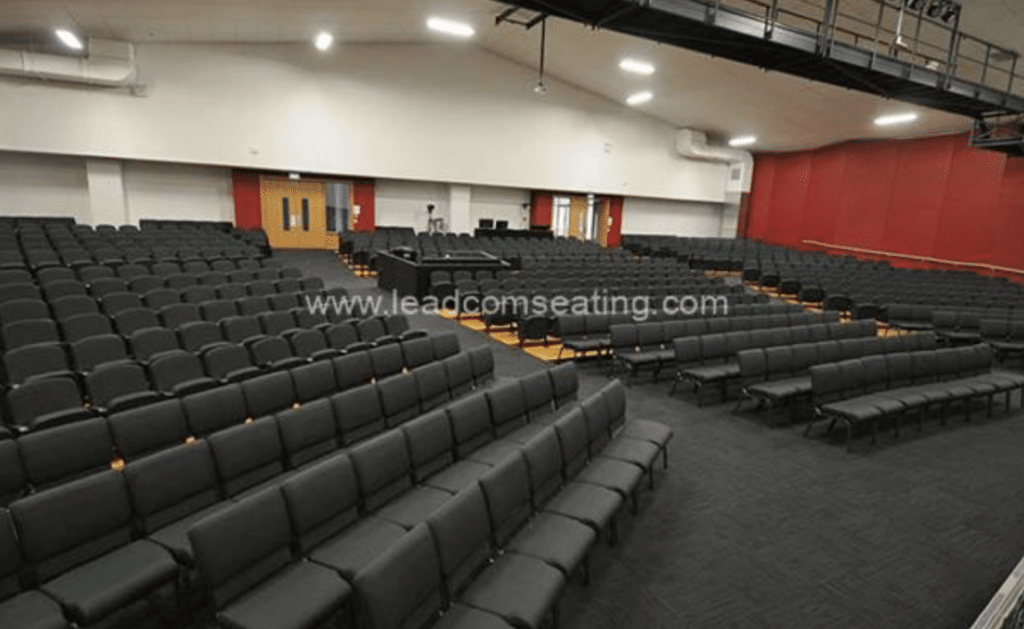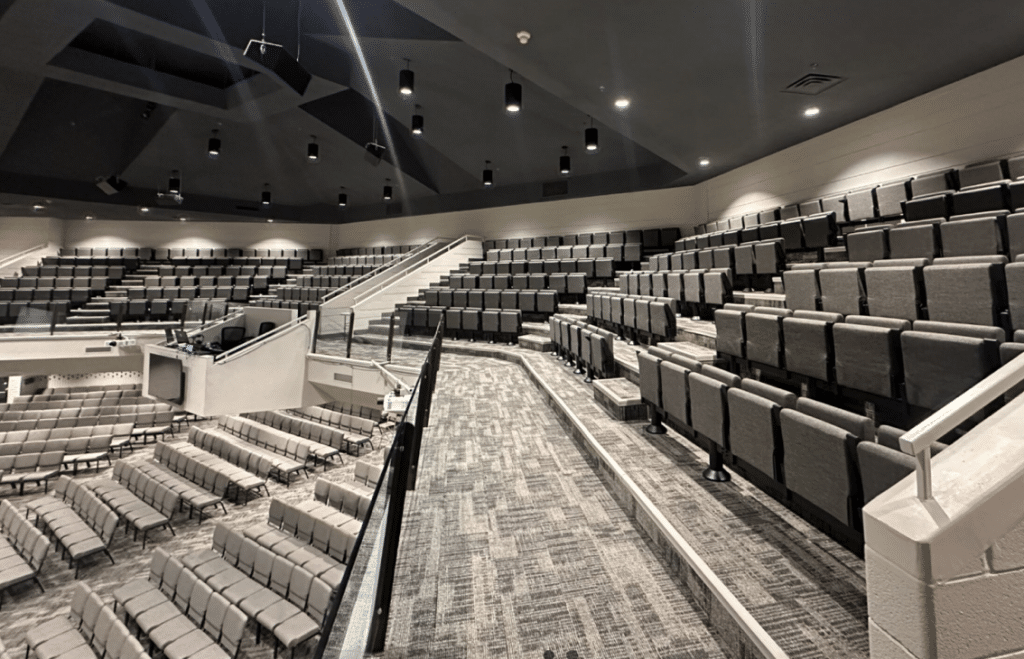Auditorium chairs are a key part of public spaces like theatres, school halls, conference centers, and churches. They shape both the way a space functions and how it feels. Since seating usually takes up a large share of the budget when designing any public space, picking the right chairs becomes an important financial decision. Different places have different seating requirements, so their budget for seating is also different. Schools focus on durability and features like writing tablets, businesses aim for comfort with a professional look, while cultural venues care more about style and acoustics. It is important to take these factors into consideration while making a budget for your seating needs.
Let’s see the different factors that influence the auditorium chairs price.
Product Tiers Based on Project Positioning
The purpose and standing of a venue heavily influence the style of auditorium chairs selected and the budget set aside for them.
- High-end Venues: In luxury theatres, prestigious universities, and cultural institutions, comfort, durability, and aesthetics are seen as essentials. These venues usually set high expectations for materials, craftsmanship, and user comfort. Auditorium chairs in these spaces often showcase premium upholstery, solid wood accents, and advanced ergonomic designs. Therefore, seating investments are made accordingly.
- Mid-end or Ordinary Venues: Civic halls, schools, and business centers typically focus on getting dependable chairs without overspending. They look for strong frames, good comfort, and a clean appearance. Materials are chosen to handle regular use while keeping overall costs reasonable.
Product Tiers Based on Different Functional Requirements
Different designs and material choices have a big impact on the cost of auditorium chairs. Let’s categorize the auditorium chairs based on the functional requirements of different places:
1. Functional Structure Requirements
(1) Fixed chairs have a simple design and are easy to install. They are a good fit for places like theatres or lecture halls where the seating layout remains constant. Their basic build usually helps keep prices lower.
(2)Folding auditorium chairs, also known as telescopic bleacher seating, are ideal for venues that need to frequently change layouts. Their flexibility allows for quick reconfiguration of the space to accommodate various events. These chairs can be effortlessly collapsed and stowed away when not in use, making them a great choice for multi-purpose halls. However, the moving parts of these units do add to the overall cost.

(3) Stackable auditorium chairs are another smart option for flexible spaces. They can be easily stacked on top of each other when not in use, helping to save storage space and allowing quick reorganization of the room.
(4) Auditorium chairs with writing tables are common in the conference hall. Built-in tables make them more practical but also raise the cost because of the extra materials and design involved.
(5) For theaters, concert halls, and other high-standard venues, seating solutions with downward airflow and sound-absorbing seat holes significantly enhance both comfort and acoustics. By directing cool air downward from the seat backrest, this system effectively maintains a pleasant temperature, even during long performances or in crowded spaces. The seatboards boast uniquely crafted holes that absorb and scatter sound waves, thereby diminishing echoes and reverberations throughout the venue.
2. Material Requirements
The material used in different parts of the auditorium chairs also affects the cost to a great level. Here is how:
(1) Chair Frame Materials
Chair frame materials have a major impact on both durability and price. Metal frames offer strong, lasting support and are ideal for high-use spaces, although they carry a higher upfront cost. On the other hand, wood frames give a warm, traditional look, often preferred in cultural or religious settings. Costs can vary based on the type and finish of the wood. Similarly, plastic frames are lightweight and more budget-friendly but may not match the long-term strength of metal or wood.
(2) Cushion and Backrest Materials
Cushion and backrest materials also play a big role in comfort and cost. High-density foam and durable fabric provide good support at a reasonable price. Similarly, leather upholstery, often chosen for premium venues, raises the cost due to material quality and maintenance needs. If you go towards synthetic covers, they offer a cheaper alternative but may trade off some durability and comfort if quality is not properly considered.
(3) Accessory Requirements
Accessories like cup holders, aisle lighting, power ports, and upgraded armrests add to user comfort and convenience, but every extra Characteristic increases the final cost. It’s important to select accessories based on actual needs to avoid pushing the budget too far.

Brand Effect on Cost
The brand of auditorium chairs you choose can greatly influence what you pay.
High-quality brands charge more because they invest in better production methods and stricter quality control. Their chairs tend to be more reliable over time, and they usually offer better after-sales support, including faster service, dependable warranties, and easier maintenance. These factors result in lower unexpected costs later on.
The full-process services these brands deliver also add to the final cost. Established brands often supply design consultation, seating layout help, installation support, and maintenance services. Although these services increase the initial price, they reduce the risk of mistakes, extend the life of the chairs, and make project management much easier.
How to Choose the Right Auditorium Chair?
Choosing the right auditorium chair takes careful planning and a step-by-step approach. Here is how you can do it:
1. Clarify the Priority of Needs
Start by identifying your primary needs first. For most places, these primary needs include comfort, durability, and safety. Secondary features like appearance or brand prestige should be considered only after the basics are covered.
2. Budget Planning
Set a clear overall budget early and divide it between seating, installation, and any necessary accessories. Leave some flexibility for adjustments after getting supplier quotes or testing samples.
3. Supplier Evaluation
Review supplier qualifications carefully. Look for certifications like ISO, proven project experience, and positive client feedback. Also, check their after-sales support, including warranty periods and service response times.
4. Field Test
Before making a final choice, it’s advisable to test sample chairs yourself. Check comfort, sturdiness, and ease of use. Sitting in the actual chair can reveal important details that brochures or catalogs often miss.

Leadcom Auditorium Chair Recommendation
Leadcom is among the top auditorium chair suppliers and presents multiple high-quality seating options for different needs. Their top three auditorium chairs for sale include:
1. Arthur Lite L-A02-1
The Arthur Lite L-A02-1 brings top flexibility to your disposal. It allows you to choose between U-shape, T-shape, or single pedestal legs, depending on your space requirements. It furnishes a plywood outer back and seat pan with a wood veneer finish, paired with ergonomic cushioning that supports the lumbar region. A spring and damping mechanism controls the smooth tip-up seat action, while the hardwood armrest houses a convenient folding writing tablet. This model is ideal for lecture halls, auditoriums, and education spaces where functionality and classic wood styling are needed.
2. Elizabeth Legend LS-625B
The Elizabeth Legend LS-625B seating solution brings elegance to your space. Its cold-molded foam cushioning offers superior comfort, making it a preferred choice for worship spaces, classic theatres, and performing arts centers. The wood-carved armrests add a sophisticated touch that blends well with traditional and cultural environments. A spring and damping mechanism ensures smooth seat movement, while the overall design focuses on creating a warm and welcoming atmosphere.
3. Romeo M04
The Romeo M04 chair is a practical solution for fellowship halls and convention centers. It boasts a durable steel frame and molded seat cushion foam for enhanced comfort. Integrated ganging hooks allow chairs to be connected for uniform row seating. For added functionality, options like a rear booknet or under-seat bookrack are available. Thereby, it’s a smart choice for places needing flexible, connected seating without sacrificing strength and stability.
Conclusion
Auditorium chairs are essential components of public spaces such as theaters, school auditoriums, and churches, and their cost directly influences the overall project budget. Given that the functional and budgetary requirements of seats vary significantly across different scenarios, decision-makers must carefully consider the cost structure of auditorium seats to formulate a reasonable budget.
As a leading auditorium chair supplier, Leadcom presents various high-quality seating options that suit your budget and needs, whether you are looking for durability, comfort, or aesthetics.
